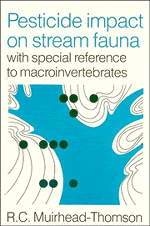Book contents
- Frontmatter
- Contents
- Preface and Acknowledgements
- PART I INTRODUCTION AND ORIGIN OF PESTICIDES IN RUNNING WATERS
- PART II THE ROLE OF LABORATORY AND EXPERIMENTAL METHODS IN EVALUATION
- THREE Laboratory evaluation techniques
- FOUR Artificial community streams and channels in situ
- FIVE Invertebrate reaction to pesticides under laboratory and experimental conditions
- PART III EVALUATION IN PEST CONTROL PROJECTS
- Summary and assessment
- References
- Index
FOUR - Artificial community streams and channels in situ
Published online by Cambridge University Press: 05 November 2011
- Frontmatter
- Contents
- Preface and Acknowledgements
- PART I INTRODUCTION AND ORIGIN OF PESTICIDES IN RUNNING WATERS
- PART II THE ROLE OF LABORATORY AND EXPERIMENTAL METHODS IN EVALUATION
- THREE Laboratory evaluation techniques
- FOUR Artificial community streams and channels in situ
- FIVE Invertebrate reaction to pesticides under laboratory and experimental conditions
- PART III EVALUATION IN PEST CONTROL PROJECTS
- Summary and assessment
- References
- Index
Summary
ARTIFICIAL STREAM COMMUNITIES
The laboratory streams described so far have been designed mainly for single species at a time, or for limited select groups of macroinvertebrates. The logical progress from this point is to design simulated streams in which impact of toxic chemical on a whole community can be studied under conditions akin to those in the natural habitat, but allowing certain factors to be controlled and studied separately in a way that is not feasible in the stream complex. Noteworthy developments along these lines have indeed been made, though not necessarily with the same objective. For example, in studies on the community effect of the lamprey larvicide TFM (see page 214) in Michigan, six fish hatchery channels 8 m long and 0.6 m wide were used, allowing three complete systems, each comprising one control and one adjacent experimental channel (Maki & Johnson, 1977). Each channel was divided into a 4 m upper pool section and a 4 m lower riffle section. The upper pool section was allowed to become colonised by introduction of organic matter and by drift of fauna in the gravity-fed water supply from an adjacent creek. The riffle section was also colonised from natural stream substrates, with associated fauna and flora introduced from a natural source. These communities were allowed to grow and become stabilised for a period of 2 months before experiments started, by which time a very good representation of stream organisms was established, including five species of stonefly (Plecoptera), three of mayflies (Ephemeroptera) and no fewer than nine species of caddis (Trichoptera), as well as the crustaceans Gammarus and Asellus.
- Type
- Chapter
- Information
- Pesticide Impact on Stream FaunaWith Special Reference to Macroinvertebrates, pp. 52 - 60Publisher: Cambridge University PressPrint publication year: 1987



